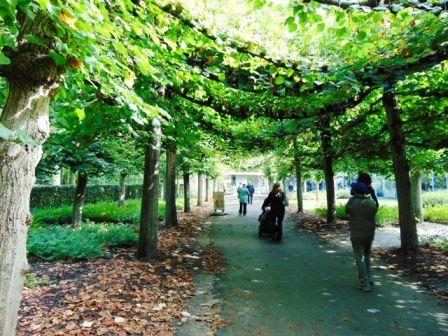An archway (or arbor, in French: cot) is a path between two hedges that are connected at the top, so that a tunnel grows. They were once planted in rich estates so damsels could walk out without come in to the sun. Because that would affect their white skin, making them distinguishable by colors from the outside working man.
 (Only in modern times was tan a sign of wealth, which showed that you could regularly afford to travel far. So, had a holiday...?)
(Only in modern times was tan a sign of wealth, which showed that you could regularly afford to travel far. So, had a holiday...?)
For an arbor and espaliered forms especially trees with flexible branches are used as pear, beech, linden.
Espalier trees can be used as a hedge or separation. They save a lot of space, and still provide a lot of fruit.
For a cordon the stem or not more than two branches retain and are fully occupied with fruit wood. To the trained direction of those, we call it a horizontal, inclined or vertical cord(on).
A double strain is a U - shape. When you double, each branch (u) is branched again (double u).
A V-shape and Belgian fence, gets above each other standing, symmetrical, inclined branchings.
The real espalier is a symmetrical shape wherein of the stem one or more pairs of side branches grow in the opposite direction in a flat horizontal plane.
In a palmette are the branches obliquely.
‘Kandelaberen’ is cut back to the main branches, so the tree gets the look of a candlestick or candelabra. By lack of acceptable translation, I’ll call it drastic pruning. All the main branches are severely shortened to a pyramidal shape at 50 cm at the top, and up to 1 meter below. Every 4-8 years, all new shoots are removed. A drastic reduction in the sycamore, lime, chestnut, locust, maple and ash can be survived. As a tree is older, the measure is more threatening (> 30 years).
The twigs should be removed before they are thicker than 2-3 cm. In cities with paved and compacted soil it is used to reduce the trees’ needs for moisture. Drastic pruning may be a preparation for later transplanting mature trees (combined with root pruning).
Sometimes it is used to save a tree. The root mortality that occurs after heavy pruning causes increased risk of wind throw, so the trees are usually removed within 25 years.
Pollard willows, it is a way to harvest regular willow twig to braid. See <Coppice and pollarding>
Topiary, pruning in special visual shapes is still popular.
Trees wound care
You can avoid or limit the bleeding of a tree by pruning when they are at rest. E.g. in November, and not much later, because the sap flow in January gets started again.
Problem when bleeding is not so much that the tree could bleed to death or could deflate. Due to the bleeding the tree will lose a part of its reserves.
Anointing or burning shut is more harmful than the bleeding itself. The bleeding stops eventually by itself. Investigation of in-rotting branch collars has shown that the tree itself, as in nature, makes the best defense against injury. The use of tree balsam and wound wax is rather poor. Below this layer is the environment for fungi and bacteria created where they just develop better.
After the bleeding wound callus formation is initiated, so callus tissue grows over the wound and protects the underlying wood.
Small branches can be torn off. It is said that this way fewer cells are cut then if you
saw off nicely and straigt, and they heal better.
A wound dressing thus seems particularly aesthetically and psychologically useful to the owner of the tree.
You can close the wounds painting with latex paint for exterior use mixed with 1/3 water glass.
It was also used to use pitch, resin, beeswax, sheep fat or mixtures thereof.
For large wounds (e.g. a fork taken away from a top) my father showed me to cover the wounds with pure clay.
(See also Bridge - grafting in <Killing a tree>)
